Animal Therapists
By Mildred Boyd

Dogs guarding our, homes, guiding the blind and tracking animals or criminals were on1y the tip of the iceberg. The army uses its canine corps in many ways and customs dogs have proved effective in sniffing out illegal drugs and terrorist bombs. It is a proven fact that people with pets to care for and love live longer and happier lives than those without such interests.
There are now a number of organizations devoted to furthering these useful interrelationships. The Delta Society, founded in 1977, is a leading international resource for the human-animal bond. The Society has been a force in validating the important role of animals for people’s health and well-being by disseminating the results of research to health and human services organizations and to the media.
Improving human health through service and therapy animals is their mission. Expanding public awareness of the positive effect animals can have on human health and development removing barriers that prevent involvement of animals in everyday life and furthering the therapeutic and service role of animals in human health service and education are their goals.
Therapet is another non-profit organization whose mission is to facilitate the use of animals in the healing and rehabilitation of acutely or chronically ill individuals. The group works to accomplish this by education and training of health care professionals, evaluation and training of animals and human volunteers and helping establish Animal Assisted Training programs wherever they are needed.
Animal therapy has become so important a part of health care that the American Kennel Club now awards the special title of Therapy Dog to those who qualify. These animals earn their titles by regularly visiting hospitals and nursing homes. They carry business cards to help patients to remember their names and, simply by being there for the ill and the lonely to touch and talk to, they accomplish small miracles with each visit.
Seriously ill children will often confide in an animal friend and, in so doing, lose some of their fears. The elderly are especially vulnerable to loneliness and depression which the animals can often alleviate. Handlers maintain that the animals can sense those who need them most and will unerringly seek them out each time they enter a hospital or nursing home. While group therapy works reasonably well, studies have shown that one animal with each patient has far more long-lasting effects on that patient’s mental and physical well being.
Not all therapy animals will fit in a hospital hall or sickroom. How about a two ton therapist? In South Africa, children with cerebral palsy and blindness are often taken to visit one in the form of an African elephant. The huge animals are gentle with their young and seem to sense when they are near a disabled child. Spending time with such large creatures is exciting and motivates hopeless and withdrawn children to help themselves.
In Israel, both therapist and patient may be all wet but the help that dolphins offer has much the same effect as that of the pachyderms. Since elephants and dolphins are not always readily available, the most frequently consulted of the large animal therapists is the horse. Children love these gentle creatures and they are called in to treat a wide variety of disabling conditions including, again, cerebral palsy and congenital blindness. Down Syndrome, delayed development, autism, stroke, traumatic brain and spinal cord injuries, convulsive disorders, amputations, muscular dystrophy, blindness and deafness are other conditions that respond well to equine therapy.
This brings us to our own Lakeside practitioners of Equine Therapy, a non- profit group called Pasos Milagrosos (Miraculous Steps). The name is no exaggeration. They provide a physician-prescribed treatment involving a horse, an instructor and a group of dedicated volunteers. Their aim is to improve the physical, psychological and social well-being of their patients.
Every day these caring people are bringing hope to severely handicapped children by using the unique relationship between the patient and the horse. As they ride the body heat and rhythmic, repetitive movement of the walking horse helps to improve muscle tone, balance, posture, coordination, strength, flexibility and cognitive skills.
Such teams are called in to treat an appalling number of devastating physical and mental disabilities which affect children. The natural affinity between children and horses makes these equine therapy sessions enjoyable experiences for the young patients and encourage them to help themselves. The child is asked to ride in many positions; sitting, lying down, facing forward, backward or sideways standing in the stirrups or without holding on.
In most cases a volunteer leads the animal while an instructor walks alongside directing the patient in assuming new postures, playing games or performing simple tasks; simple, that is, for most children. Changing positions on a moving animal or catching a large ball and dropping it through a hoop is far from simple for most of these youngsters.
Failures are met only with encouragement to try again. Each success elicits warm praise but it is the delighted feeling of triumph as the child realizes his own accomplishment that is the real reward for all concerned. If, as sometimes happens, that child reaches the point where he can actually take the reins and guide the horse himself, that is no small step; that is a true miracle!
- April 2024 – Issue - March 31, 2024
- April 2024 – Articles - March 31, 2024
- April 2024 - March 31, 2024






